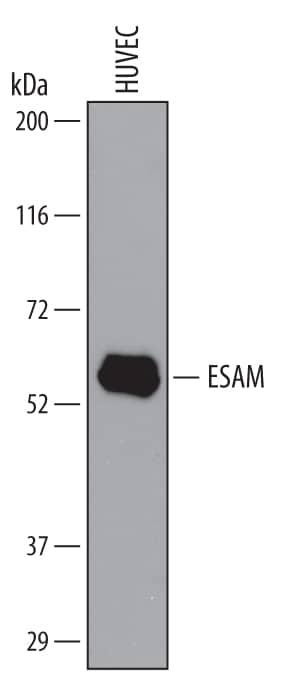Human ESAM Antibody
R&D Systems, part of Bio-Techne | Catalog # AF2688

Key Product Details
Species Reactivity
Validated:
Cited:
Applications
Validated:
Cited:
Label
Antibody Source
Product Specifications
Immunogen
Gln30-Ala247
Accession # Q96AP7
Specificity
Clonality
Host
Isotype
Scientific Data Images for Human ESAM Antibody
Detection of Human ESAM by Western Blot.
Western blot shows lysates of HUVEC human umbilical vein endothelial cells. PVDF membrane was probed with 1 µg/mL of Goat Anti-Human ESAM Antigen Affinity-purified Polyclonal Antibody (Catalog # AF2688) followed by HRP-conjugated Anti-Goat IgG Secondary Antibody (Catalog # HAF019). A specific band was detected for ESAM at approximately 55 kDa (as indicated). This experiment was conducted under reducing conditions and using Immunoblot Buffer Group 1.Detection of ESAM in HUVEC Human Cells by Flow Cytometry.
HUVEC human umbilical vein endothelial cells were stained with Goat Anti-Human ESAM Antigen Affinity-purified Polyclonal Antibody (Catalog # AF2688, filled histogram) or control antibody (Catalog # AB-108-C, open histogram), followed by Phycoerythrin-conjugated Anti-Goat IgG Secondary Antibody (Catalog # F0107).Applications for Human ESAM Antibody
CyTOF-ready
Flow Cytometry
Sample: HUVEC human umbilical vein endothelial cells
Immunohistochemistry
Sample: Immersion fixed paraffin-embedded sections of human kidney and liver
Western Blot
Sample: HUVEC human umbilical vein endothelial cells
Formulation, Preparation, and Storage
Purification
Reconstitution
Formulation
Shipping
Stability & Storage
- 12 months from date of receipt, -20 to -70 °C as supplied.
- 1 month, 2 to 8 °C under sterile conditions after reconstitution.
- 6 months, -20 to -70 °C under sterile conditions after reconstitution.
Background: ESAM
Endothelial cell-selective adhesion molecule (ESAM) is a 55 kDa type I transmembrane glycoprotein that belongs to the JAM family of immunoglobulin superfamily molecules (1, 2). Human ESAM is synthesized as a 390 amino acid (aa) protein composed of a 29 aa signal peptide, a 216 aa extracellular region, a putative 26 aa transmembrane segment, and a 119 aa cytoplasmic domain. The extracellular region contains one V-type and one C2-type Ig domain and is involved in homophilic adhesion (1). In the cytoplasmic domain, there is a docking site for the multifunctional adaptor protein MAGI-1 (3). The extracellular region of human ESAM shows 90%, 74%, 69% and 67% aa identity with monkey, canine, mouse and rat extracellular ESAM, respectively. ESAM is expressed on endothelial cells, activated platelets and megakaryocytes, and can be found associated with cell-to-cell junctions. Whether ESAM is restricted to a particular junctional type is not clear (1, 2). ESAM deficient mice have no defect in vascularization but do have reduced angiogenic potential. This may be due to a decreased migratory response to FGF-2 (4).
References
- Hirata, K-I, et al. (2001) J. Biol. Chem. 276:16223.
- Nasdala, I. et al. (2002) J. Biol. Chem. 277:16294.
- Wegmann, F. et al. (2004) Exp. Cell Res. 300:121.
- Ishida, T. et. al. (2003) J. Biol. Chem. 278:34598.
Long Name
Alternate Names
Gene Symbol
UniProt
Additional ESAM Products
Product Documents for Human ESAM Antibody
Product Specific Notices for Human ESAM Antibody
For research use only

